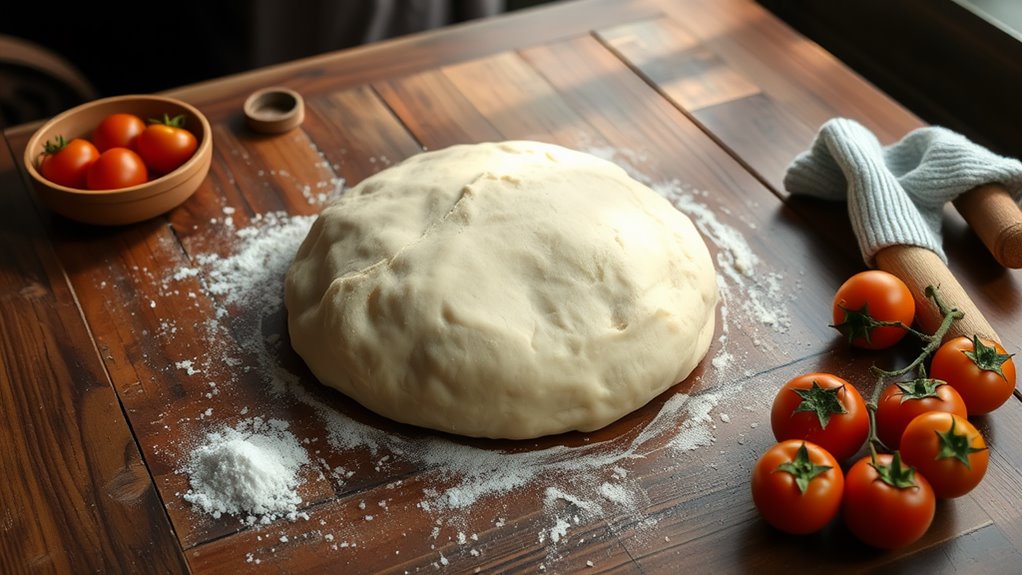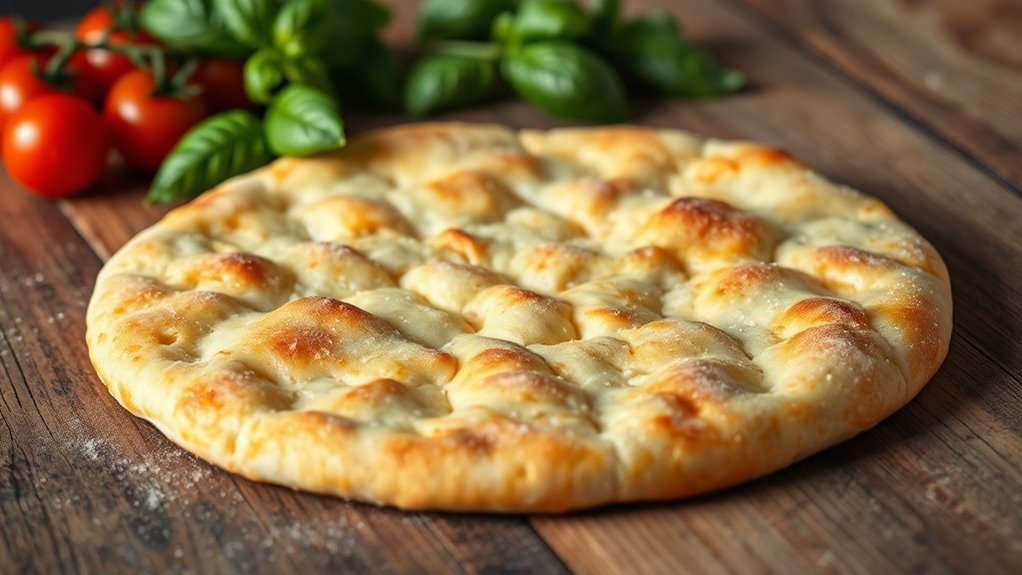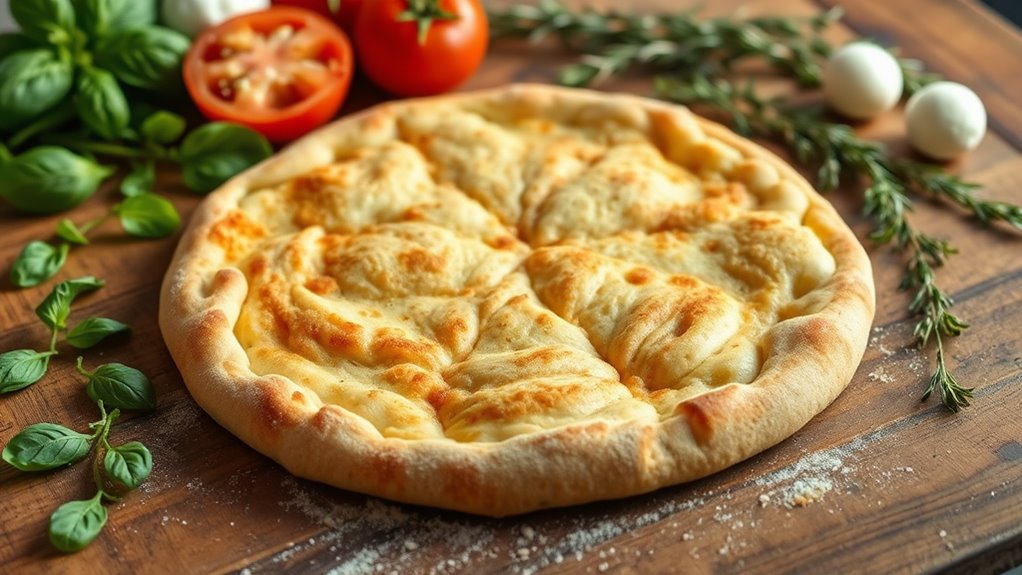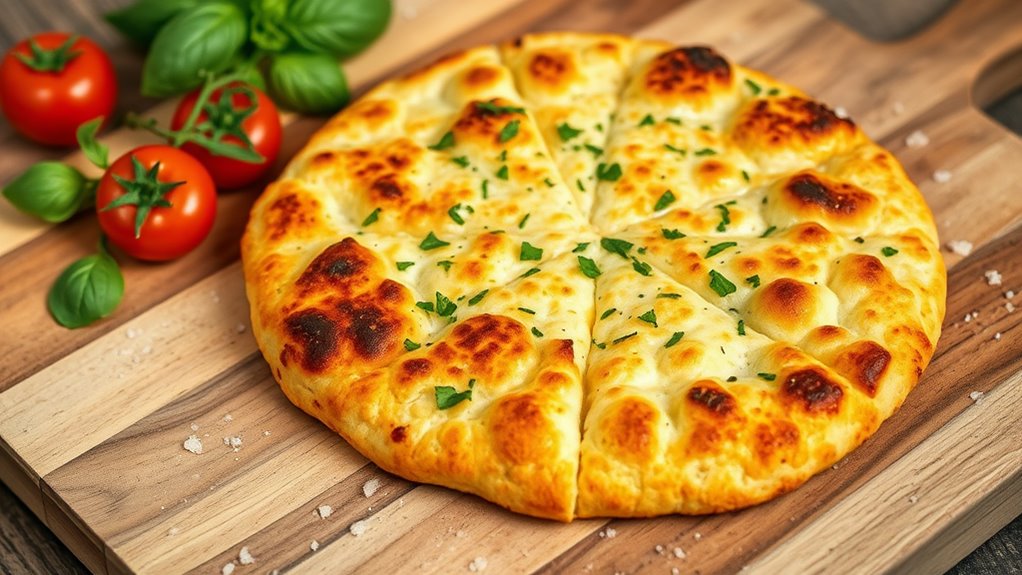When you think about making pizza at home, the foundation really matters. You've got options like the classic Neapolitan dough for that perfect chew, or a thin crust for a crunchier bite. If you're looking for something gluten-free, there's a cauliflower crust that balances health and flavor, while whole wheat dough brings a nutty twist. Each recipe not only caters to different tastes but also invites you to experiment with toppings. So, which base will you choose to enhance your pizza game? Let's investigate these recipes to find the one that suits you best.
Classic Neapolitan Pizza Dough

Classic Neapolitan pizza dough is the foundation of one of the most beloved pizza styles in the world. With a simple combination of flour, water, salt, and yeast, this dough is known for its soft, airy texture and slightly chewy crust, making it perfect for high-temperature baking in a wood-fired oven. Following this recipe will guide you to create a perfect dough that will rise beautifully and develop a rich flavor, ready to be topped with your favorite ingredients.
Ingredients:
- 4 cups (500g) 00 flour or all-purpose flour
- 1 ½ teaspoons (8g) sea salt
- 1 teaspoon (4g) active dry yeast
- 1 ½ cups (360ml) lukewarm water
- 1 teaspoon sugar (optional, to help activate the yeast)
To make the dough, start by dissolving the yeast and sugar (if using) in lukewarm water and let it sit for about 5-10 minutes until foamy.
In a large mixing bowl, combine the flour and salt. Gradually pour the yeast mixture into the flour while stirring with a wooden spoon or your hand until it comes together.
Once combined, knead the dough on a floured surface for about 10-15 minutes until it's smooth and elastic. Transfer the dough to a lightly oiled bowl, cover it with a damp cloth, and let it rise in a warm place for 1-2 hours, or until it has doubled in size.
Once risen, punch down the dough, divide it into 2-4 equal portions, shape them into balls, and let them rest for another 30 minutes before stretching them out into pizza bases.
When preparing your Neapolitan pizza dough, it's important to use high-quality flour, preferably '00' flour, which has a fine texture and high protein content, ideal for creating a chewy crust.
Additionally, allow the dough to rise slowly in the fridge for up to 24 hours for improved flavor development.
When ready to bake, preheat your oven to its highest setting (ideally around 475°F to 500°F or 250°C) and use a pizza stone if you have one to achieve that perfect crust.
Finally, avoid overworking the dough when shaping it; gentle handling will help maintain the air bubbles and create a light, airy crust.
Thin Crust Pizza Base

Thin crust pizza is a delightful and crispy base for any pizza lover who prefers a lighter option. This style of pizza has a satisfyingly crunchy texture and allows the toppings to shine through without overwhelming the palate.
With just a few simple ingredients and a straightforward preparation process, you can whip up your own thin crust pizza base at home, ready to be topped with your favorite ingredients and baked to perfection.
Ingredients:
- 2 cups all-purpose flour
- 1 teaspoon salt
- 1 teaspoon sugar
- 1/2 teaspoon active dry yeast
- 3/4 cup warm water (about 110°F)
- 1 tablespoon olive oil
- Cornmeal (for dusting)
Instructions:
In a large mixing bowl, combine the all-purpose flour, salt, sugar, and active dry yeast. Gradually add the warm water and olive oil, mixing until a dough forms.
Knead the dough on a lightly floured surface for about 5-7 minutes until it becomes smooth and elastic. Once kneaded, place the dough in a greased bowl, cover it with a damp cloth, and let it rise in a warm place for about 30 minutes, or until it has doubled in size.
After the dough has risen, preheat your oven to 475°F (245°C). Roll out the dough on a floured surface to your desired thickness, ideally around 1/8 inch for a thin crust.
Transfer the rolled dough onto a cornmeal-dusted pizza stone or baking sheet. Add your preferred sauce and toppings, then bake for 12-15 minutes, or until the crust is golden brown and crispy.
Extra Tips:
To achieve the best texture, make sure that your oven is preheated properly before baking your pizza.
For an extra crunch, consider par-baking the crust for 5 minutes before adding toppings. This will help make sure that your crust remains crisp and doesn't become soggy from the toppings.
If you prefer a more flavorful base, feel free to add herbs or spices to the dough, such as garlic powder, oregano, or Italian seasoning.
Enjoy experimenting with different toppings to create your perfect thin crust pizza!
Gluten-Free Pizza Crust

Gluten-free pizza crust is a delicious and satisfying alternative for those who need to avoid gluten. This recipe uses a blend of gluten-free flours and other wholesome ingredients to create a crust that isn't only easy to make but also holds up well under your favorite toppings.
Whether you're hosting a pizza night or just craving a slice, this crust will let you enjoy pizza without the gluten.
Ingredients:
- 1 cup gluten-free all-purpose flour
- 1/2 cup almond flour
- 1 teaspoon baking powder
- 1/2 teaspoon salt
- 1 teaspoon garlic powder
- 1/4 cup olive oil
- 1/2 cup warm water
- 1 teaspoon apple cider vinegar
Instructions:
In a large mixing bowl, combine the gluten-free all-purpose flour, almond flour, baking powder, salt, and garlic powder. Mix well.
In a separate bowl, whisk together the olive oil, warm water, and apple cider vinegar. Gradually pour the wet mixture into the dry ingredients, stirring until a dough forms. If the dough feels too sticky, add a little more gluten-free flour.
Preheat your oven to 425°F (220°C). On a parchment-lined baking sheet, press the dough into your desired pizza shape, about 1/4 inch thick. Bake for 10-12 minutes, until the crust is lightly golden.
Remove from the oven, add your favorite toppings, and return to the oven for an additional 10-15 minutes until the toppings are cooked to your liking.
Extra Tips:
When making gluten-free pizza crust, it's important to let the dough rest for a few minutes before shaping it. This allows the flours to absorb moisture and can lead to a better texture.
Additionally, you can experiment with different gluten-free flour blends to find your preferred taste and texture. For a crispier crust, consider pre-baking the crust for a few extra minutes before adding toppings.
Finally, remember that gluten-free dough can be more delicate, so handle it gently to maintain its structure. Enjoy your homemade gluten-free pizza!
Cauliflower Pizza Base

Cauliflower pizza base is a fantastic alternative for those looking to enjoy pizza while keeping their carb intake low. This gluten-free option is easy to prepare and can be tailored to your taste preferences.
With its subtle flavor and satisfying texture, a cauliflower pizza base is perfect for any topping you desire, making it a versatile choice for pizza lovers of all kinds.
Ingredients:
- 1 medium head of cauliflower
- 1 cup shredded mozzarella cheese
- 1/4 cup grated Parmesan cheese
- 1 large egg
- 1 teaspoon garlic powder
- 1 teaspoon onion powder
- 1 teaspoon dried oregano
- Salt and pepper to taste
Instructions:
Preheat your oven to 425°F (220°C) and line a baking sheet with parchment paper.
Begin by removing the leaves and stems from the cauliflower and cutting it into florets. Place the florets in a food processor and pulse until it resembles rice or fine crumbs.
Transfer the processed cauliflower to a microwave-safe bowl and microwave for about 8 minutes, covered, until tender. Allow the cauliflower to cool slightly, then use a clean kitchen towel to wring out excess moisture.
In a mixing bowl, combine the cauliflower, mozzarella cheese, Parmesan cheese, egg, garlic powder, onion powder, oregano, salt, and pepper. Mix until well combined.
Shape the mixture into a pizza base on the prepared baking sheet, about 1/4 inch thick. Bake for 15-20 minutes or until golden brown, then add your favorite toppings and return to the oven to melt the cheese.
Extra Tips:
For the best results, make sure to squeeze out as much moisture as possible from the cooked cauliflower; this will help the pizza base hold its shape and avoid sogginess.
You can experiment with different herbs and spices to improve the flavor of your base. If you're looking for a bit more crunch, consider pre-baking the base for a few extra minutes before adding your toppings.
Additionally, you can prepare the cauliflower base ahead of time and store it in the refrigerator or freezer until you're ready to use it.
Whole Wheat Pizza Dough

Whole wheat pizza dough is a healthier alternative to traditional pizza crusts, offering a nutty flavor and added nutritional benefits. This dough is easy to make and can be used as a base for your favorite toppings, whether you're a fan of classic margherita, loaded veggie, or meat lovers.
The whole wheat flour provides more fiber and nutrients compared to all-purpose flour, making your pizza not just delicious but also more wholesome.
Ingredients:
- 2 cups whole wheat flour
- 1 cup warm water (about 110°F)
- 1 packet (2 ¼ teaspoons) active dry yeast
- 1 tablespoon olive oil
- 1 teaspoon salt
- 1 teaspoon sugar
Instructions:
In a large mixing bowl, combine the warm water, sugar, and yeast. Allow it to sit for about 5-10 minutes until it becomes frothy.
Add the olive oil and salt, then gradually mix in the whole wheat flour, stirring until a dough forms. Knead the dough on a lightly floured surface for about 8-10 minutes until smooth and elastic.
Place the dough in a greased bowl, cover it with a clean cloth, and let it rise in a warm place for about 1 hour or until it has doubled in size.
Once risen, punch down the dough, roll it out to your desired thickness, and place it on a pizza stone or baking sheet. Pre-bake the crust at 450°F for about 5-7 minutes before adding your favorite toppings and baking again until the cheese is bubbly and golden.
Extra Tips:
For the best results, make sure that your water is warm but not too hot, as overly hot water can kill the yeast.
If you want a more flavorful dough, consider adding herbs like oregano or garlic powder to the flour mixture. You can also let the dough rise in the refrigerator overnight for a deeper flavor.
Finally, don't be afraid to experiment with different toppings to create your perfect pizza!
